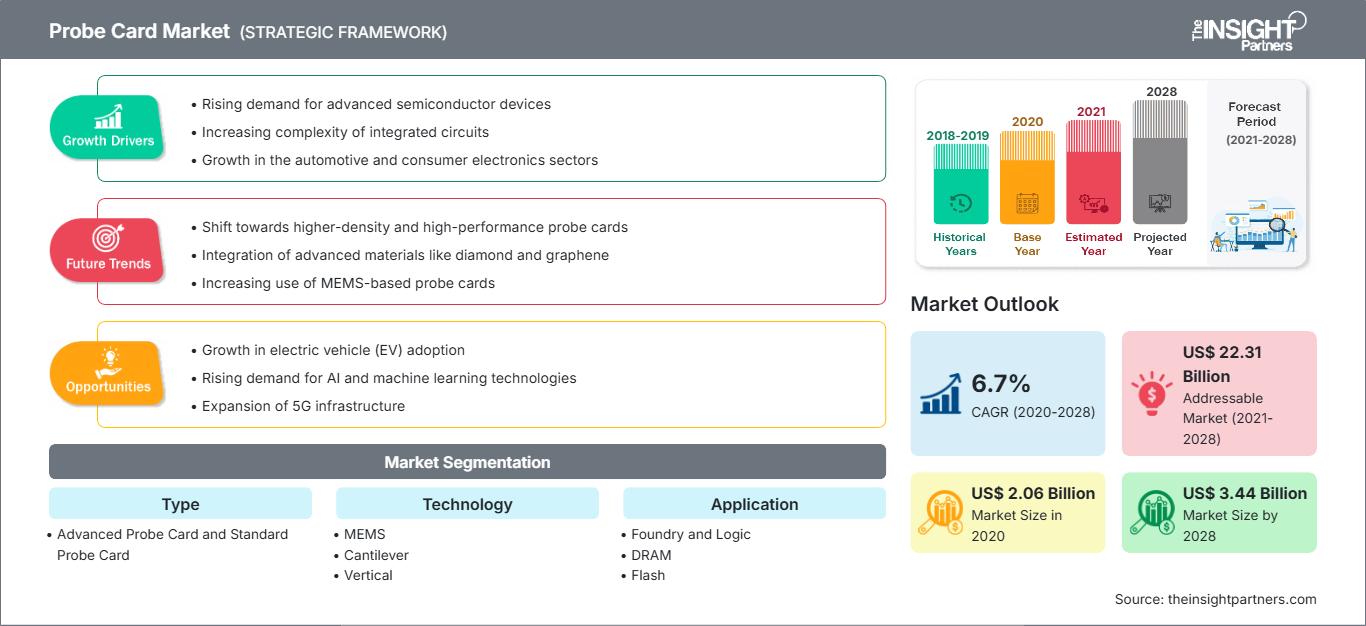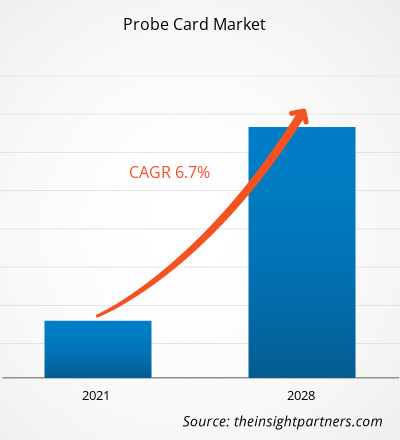The probe card market size is projected to reach US$ 3,436.80 million by 2028 from US$ 2,059.80 million in 2020; it is expected to witness healthy market growth of 6.7% CAGR during 2021–2028.
A probe card is an interface that allows a semiconductor wafer to be tested. In the initial step of semiconductor manufacturing, this procedure is used to assess the quality of integrated circuits or latent semantic indexing. In most cases, the probe card is mechanically docked to a prober and electrically linked to a tester. A probe card's principal purpose is to establish an electrical connection between the test equipment and the circuits on the wafer, allowing the circuits to be tested. Printed circuit boards (PCB) and various types of contact elements are the fundamental components of probe cards. A probe card considers a variety of elements, some of which are quite common and others that have highly specific use.
The consumer electronics business has evolved as a result of increased usage of cellphones, desktops, digital cameras, tablets, laptops, hard drives, and televisions, among other things, as well as constant research and introduction of new technologies. The introduction of smart gadgets and the Internet of Things, as well as the expanding acceptance of tablets and the spike in demand for devices with huge screens, are all contributing to the probe market growth. The demand for semiconductors has been fueled by changes in chip size trends and a rising preference for creative architecture in various electronic products. The increasing size of IC chip manufacturing resulted in a boom in the demand for electronics testing, which is driving up the need for probe cards. The incorporation of modern technologies, such as AI and IoT, into semiconductor production equipment will hasten their acceptance in fabrication facilities. Furthermore, increased need for silicon-based sensors for IoT devices, expanding chip industry presence in emerging nations, and an increase in the number of data centers and servers are factors that assist raise the semiconductor industry's performance, which, in turn, contribute to probe card demand.
The worldwide lockdown to minimize the transmission of virus has significantly disrupted the supply chain activities along with production volume across several manufacturers especially the small & medium enterprise owners. The semiconductor industry took a significant hit as the demand for electronic components was lowered from industrial sector and end users. The revenue model for microelectronics has declined as no mass production was carried in the lockdown period. Post lockdown, the semiconductor industry started to regain the market share as production facilities restarted the operation by taking social distancing measures. Besides, work from home and remote monitoring strategies also helped increase the sale of advanced electronics products for better connectivity. IT and telecommunication industry importance have been highlighted for the communicational purpose, which allowed the industry to evolve with new technologies such as IoT connectivity and high-speed Wi-Fi compatible packaging technology.
Customize This Report To Suit Your Requirement
You will get customization on any report - free of charge - including parts of this report, or country-level analysis, Excel Data pack, as well as avail great offers and discounts for start-ups & universities
Probe Card Market: Strategic Insights

-
Get Top Key Market Trends of this report.This FREE sample will include data analysis, ranging from market trends to estimates and forecasts.
Based on the probe card market report, Asia Pacific is expected to hold majority of the share in the global probe card market share. Asia Pacific comprises the largest and most dynamic economies such as China, India, Japan, Australia, and South Korea. Taiwan, China, and Japan are the leading semiconductor manufacturing countries in Asia Pacific. The rising disposable income in developing countries such as India and China, is leading to a large client base for high-tech consumer electronics such as smart wearables, smartphones, and electric vehicles. This factor is expected to drive the probe card market in the region. China is a leading manufacturing hub for the IC packaging technology-based products, while Taiwan, South Korea, and Japan are also significant contributors to the regional market growth. Many of the Asia Pacific countries are characterized by the mass production of electronic devices required for consumer electronics, automotive components, telecommunication devices, and other industrial machineries. The rising number of electronics manufacturing companies in India and China, owing to strong availability of skilled human resources, is driving the probe card market growth.
Probe Card Market Segments
Based on probe card market analysis, the market is segmented into type, technology, application, and geography. Based on type, the probe card market is segmented into advanced probe card and standard probe card. On the basis of technology, the probe card market is segmented into MEMS, cantilever, and vertical. And based on application, probe card market is segmented into foundry and logic, DRAM, flash, and others. The geographic analysis is conducted based on regions such as North America, Europe, Asia Pacific (APAC), and Rest of the World (RoW).
Some of the key probe card market players are FEINMETALL GmbH; FormFactor; Fujitsu; GGB Industries; Japan Electronic Materials Corporation; Korea Instrument Co.,Ltd.; Micronics Japan Co., Ltd.; MPI Corporation; SV Probe; and Technoprobe S.p.A.
Type-Based Probe Card Market Insights
Based on type, the global probe card market is segmented into advanced probe card and standard probe card. Probe card is an interface, or a board used to conduct wafer testing for a semiconductor wafer. There are essentially three kinds of tests that are performed using a probe card—DC test, AC test, and function test.
Probe Card Market Regional Insights
The regional trends and factors influencing the Probe Card Market throughout the forecast period have been thoroughly explained by the analysts at The Insight Partners. This section also discusses Probe Card Market segments and geography across North America, Europe, Asia Pacific, Middle East and Africa, and South and Central America.
Probe Card Market Report Scope
| Report Attribute | Details |
|---|---|
| Market size in 2020 | US$ 2.06 Billion |
| Market Size by 2028 | US$ 3.44 Billion |
| Global CAGR (2020 - 2028) | 6.7% |
| Historical Data | 2018-2019 |
| Forecast period | 2021-2028 |
| Segments Covered |
By Type
|
| Regions and Countries Covered |
North America
|
| Market leaders and key company profiles |
|
Probe Card Market Players Density: Understanding Its Impact on Business Dynamics
The Probe Card Market is growing rapidly, driven by increasing end-user demand due to factors such as evolving consumer preferences, technological advancements, and greater awareness of the product's benefits. As demand rises, businesses are expanding their offerings, innovating to meet consumer needs, and capitalizing on emerging trends, which further fuels market growth.

- Get the Probe Card Market top key players overview
The players profiled in the probe card market report are mainly focused on the development of advanced and efficient products. Probe card market companies are implementing various strategies to match the technological advancements in the probe card market.
- In 2020, FormFactor announced Cryogenic Probe Family for emerging computing applications.
- In 2020, Technoprobe acquired Microfabrica.
Frequently Asked Questions
Which factor is driving the growth of the probe card market?
Which type segment led the probe card market?
Which region led the probe card market in 2020?
- Historical Analysis (2 Years), Base Year, Forecast (7 Years) with CAGR
- PEST and SWOT Analysis
- Market Size Value / Volume - Global, Regional, Country
- Industry and Competitive Landscape
- Excel Dataset
Recent Reports
Testimonials
Reason to Buy
- Informed Decision-Making
- Understanding Market Dynamics
- Competitive Analysis
- Identifying Emerging Markets
- Customer Insights
- Market Forecasts
- Risk Mitigation
- Boosting Operational Efficiency
- Strategic Planning
- Investment Justification
- Tracking Industry Innovations
- Aligning with Regulatory Trends





















 Get Free Sample For
Get Free Sample For